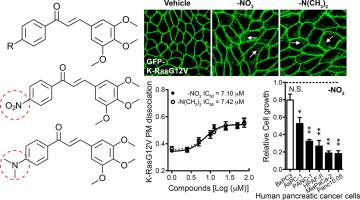当前位置:
X-MOL 学术
›
Bioorg. Med. Chem. Lett.
›
论文详情
Our official English website, www.x-mol.net, welcomes your feedback! (Note: you will need to create a separate account there.)
Chalcones bearing a 3,4,5-trimethoxyphenyl motif are capable of selectively inhibiting oncogenic K-Ras signaling.
Bioorganic & Medicinal Chemistry Letters ( IF 2.7 ) Pub Date : 2020-03-28 , DOI: 10.1016/j.bmcl.2020.127144 Sarah E Kovar 1 , Cody Fourman 2 , Christine Kinstedt 2 , Brandon Williams 2 , Christopher Morris 2 , Kwang-Jin Cho 1 , Daniel M Ketcha 2
Bioorganic & Medicinal Chemistry Letters ( IF 2.7 ) Pub Date : 2020-03-28 , DOI: 10.1016/j.bmcl.2020.127144 Sarah E Kovar 1 , Cody Fourman 2 , Christine Kinstedt 2 , Brandon Williams 2 , Christopher Morris 2 , Kwang-Jin Cho 1 , Daniel M Ketcha 2
Affiliation

|
Ras proteins are small GTPases which regulate cellular proliferation, differentiation, and apoptosis. Constitutively active mutant Ras are expressed in ~15-20% human cancers, and K-Ras mutations account for ~85% of all Ras mutations. Despite the significance of Ras proteins in refractory cancers, there is no anti-Ras drug available in clinic. Since K-Ras must interact with the plasma membrane (PM) for biological activity, inhibition of the K-Ras/PM interaction is a tractable approach to block oncogenic K-Ras activity. Here, we discovered chalcones 1 and 8 exhibit anti-K-Ras activity, and show that the compounds mislocalize K-Ras from the PM and block oncogenic K-Ras signal output. Also, 1 inhibits the growth of K-Ras-driven human cancer cells. Our data suggest that 1 could be a promising starting point for developing anti-K-Ras cancer drug.
中文翻译:

带有3,4,5-三甲氧基苯基基序的查耳酮能够选择性抑制致癌的K-Ras信号传导。
Ras蛋白是小的GTPases,可调节细胞增殖,分化和凋亡。组成型活性突变型Ras在约15-20%的人类癌症中表达,K-Ras突变占所有Ras突变的〜85%。尽管Ras蛋白在难治性癌症中具有重要意义,但临床上尚无抗Ras药物。由于K-Ras必须与质膜(PM)相互作用才能发挥生物学活性,因此抑制K-Ras / PM相互作用是阻止致癌K-Ras活性的一种容易处理的方法。在这里,我们发现查耳酮1和8表现出抗K-Ras活性,并表明该化合物使PM中的K-Ras错位并阻止了致癌的K-Ras信号输出。同样,1抑制K-Ras驱动的人类癌细胞的生长。我们的数据表明1可能是开发抗K-Ras癌症药物的有希望的起点。
更新日期:2020-04-20
中文翻译:

带有3,4,5-三甲氧基苯基基序的查耳酮能够选择性抑制致癌的K-Ras信号传导。
Ras蛋白是小的GTPases,可调节细胞增殖,分化和凋亡。组成型活性突变型Ras在约15-20%的人类癌症中表达,K-Ras突变占所有Ras突变的〜85%。尽管Ras蛋白在难治性癌症中具有重要意义,但临床上尚无抗Ras药物。由于K-Ras必须与质膜(PM)相互作用才能发挥生物学活性,因此抑制K-Ras / PM相互作用是阻止致癌K-Ras活性的一种容易处理的方法。在这里,我们发现查耳酮1和8表现出抗K-Ras活性,并表明该化合物使PM中的K-Ras错位并阻止了致癌的K-Ras信号输出。同样,1抑制K-Ras驱动的人类癌细胞的生长。我们的数据表明1可能是开发抗K-Ras癌症药物的有希望的起点。


























 京公网安备 11010802027423号
京公网安备 11010802027423号